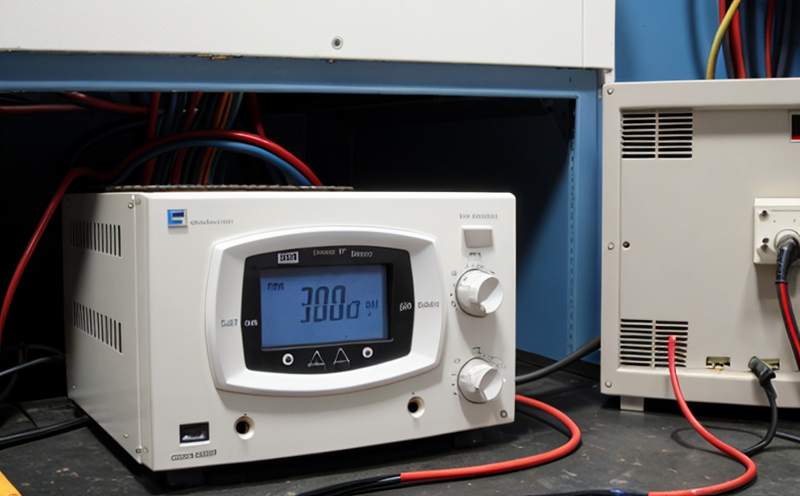EN 55024 EMC Immunity Testing of Lighting Electronic Devices
The European standard EN 55024 defines limits and methods for measuring immunity to conducted, radiated electromagnetic interference (EMI) emissions in lighting electronic devices. This testing ensures that these devices meet the stringent requirements set forth by international standards organizations.
EN 55024 is particularly important for manufacturers of LED lights, lamps with integrated electronics, and other similar products. The standard aims to ensure that such devices can operate effectively without being affected by electromagnetic interference from nearby sources. This includes household lighting systems, streetlights, and any other electronic components in the vicinity.
The testing procedure involves exposing the device under test (DUT) to specific frequency bands of conducted and radiated emissions. The DUT is placed within a test chamber where it is subjected to these electromagnetic fields. The test aims at assessing whether the device can function correctly while exposed to both conducted and radiated interference.
The standard specifies detailed measurement procedures, including the setup of the test environment, the characteristics of the interfering signals, and the criteria used for evaluating compliance. Compliance with EN 55024 is essential for manufacturers aiming to meet EU directives on electromagnetic compatibility (EMC).
Failure to comply can result in product recalls, fines, or even market bans, leading to significant financial losses. Therefore, it's crucial that lighting electronic devices undergo comprehensive EMC testing as per the EN 55024 standard.
The testing process typically involves several steps:
- Preparation of the DUT according to specified guidelines.
- Placement and setup within the test chamber.
- Application of conducted and radiated interference signals.
- Data collection and analysis.
- Evaluation against predefined limits.
The results from this testing are critical for ensuring that lighting products can coexist in the same environment without causing or being affected by electromagnetic interference. This is particularly important given the increasing complexity of modern electronic devices and the potential for interference issues to arise in crowded environments such as office buildings, public spaces, and residential areas.
Compliance with EN 55024 not only protects consumers from potentially harmful electromagnetic interference but also ensures that lighting products can operate reliably under various environmental conditions. This is especially important given the growing trend towards energy-efficient LED lighting solutions, which rely heavily on electronic components.
The standard's requirements are designed to ensure that lighting devices meet stringent limits for conducted and radiated emissions, thereby promoting a cleaner electromagnetic environment. By adhering to these standards, manufacturers can help reduce the overall level of EMI in public spaces and improve the performance of other sensitive electronic devices nearby.
Benefits
The benefits of undergoing EN 55024 EMC immunity testing extend beyond mere compliance with regulatory requirements. By ensuring that lighting electronic devices meet these stringent standards, manufacturers can reap several advantages:
- Market Access: Compliance with international standards like EN 55024 opens doors to markets in Europe and other regions that have adopted similar directives.
- Consumer Trust: Demonstrating adherence to recognized EMC standards enhances consumer confidence, fostering brand loyalty and trust.
- Economic Savings: By identifying potential issues early through rigorous testing, manufacturers can avoid costly recall campaigns and product redesigns.
- Innovation: The detailed requirements of EN 55024 encourage continuous improvement in product design and functionality, driving innovation within the industry.
The standard also supports broader goals related to sustainability and environmental protection. By reducing electromagnetic interference, lighting devices can contribute to a cleaner electromagnetic environment, supporting the overall health and well-being of individuals and communities.
In summary, EN 55024 EMC immunity testing is not just a compliance requirement; it's an essential step in ensuring product quality, enhancing consumer trust, and fostering innovation within the lighting industry.
Customer Impact and Satisfaction
- Better Product Performance: Customers benefit from products that perform reliably under various environmental conditions.
- Increased Safety: Compliance with EMC standards ensures that lighting devices do not interfere with other electronic equipment, reducing potential hazards.
- Sustained Quality: Continuous testing and adherence to standards ensure consistent product quality across all batches.
- Eco-Friendly Solutions: By minimizing electromagnetic interference, compliant products contribute to a cleaner environment.
The overall satisfaction of customers is enhanced when they receive lighting solutions that are reliable, safe, and environmentally friendly. This is particularly important given the increasing emphasis on sustainability and consumer trust in reputable brands.
By ensuring that their products meet or exceed EN 55024 standards, manufacturers can build a strong reputation for delivering high-quality lighting electronic devices. This, in turn, leads to higher customer satisfaction and loyalty, creating a positive feedback loop that benefits both the manufacturer and end-users.
Use Cases and Application Examples
| Use Case | Description |
|---|---|
| LED Street Lighting | Ensuring that LED street lights can operate effectively in urban environments where they are exposed to numerous electronic devices and sources of EMI. |
| Office Lighting Systems | Verifying the performance of office lighting systems in a shared workspace with other sensitive electronic equipment. |
| Hospital Lighting | Testing hospital-grade lighting to ensure it does not interfere with medical devices and can function reliably in an EMI-rich environment. |
| Residential LED Lamps | Evaluating the performance of residential LED lamps under household conditions, including proximity to other home electronics. |
| Data Center Lighting | Ensuring that lighting systems in data centers do not interfere with sensitive IT equipment and can operate reliably despite high levels of EMI. |
The use cases for EN 55024 EMC immunity testing are diverse, reflecting the wide range of applications for lighting electronic devices. Whether it's in public spaces or private homes, ensuring that these devices meet the stringent requirements set forth by the standard is crucial.
By adhering to EN 55024, manufacturers can ensure that their products perform reliably across different environments and conditions. This not only enhances customer satisfaction but also helps build a strong reputation in the industry.





